brakes PORSCHE PANAMERA 2010 1.G Owners Manual
[x] Cancel search | Manufacturer: PORSCHE, Model Year: 2010, Model line: PANAMERA, Model: PORSCHE PANAMERA 2010 1.GPages: 343, PDF Size: 7.96 MB
Page 5 of 343
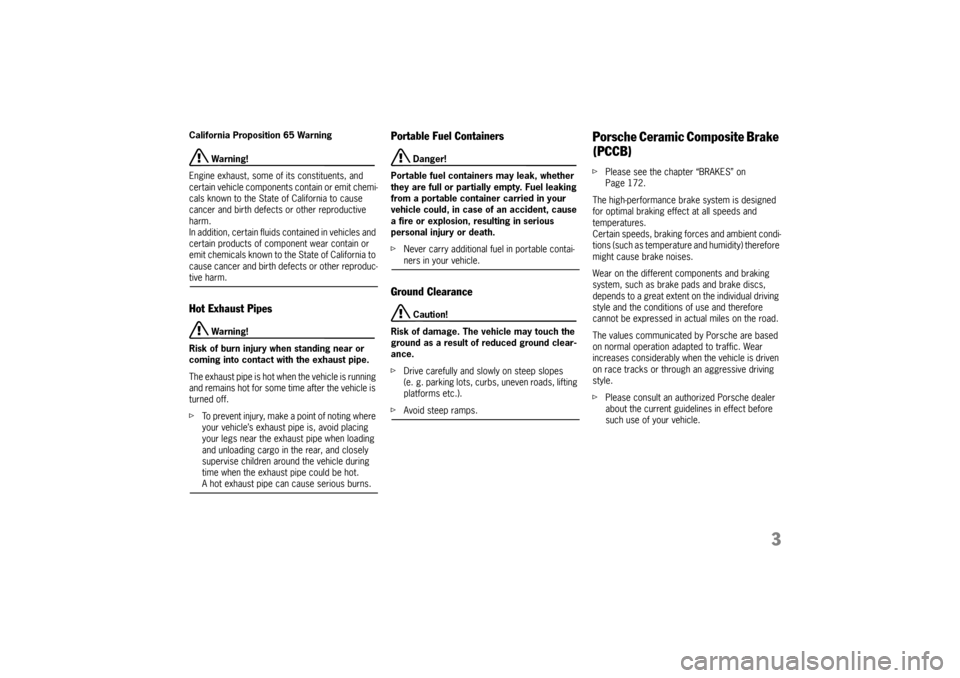
3
California Proposition 65 Warning
Warning!
Engine exhaust, some of its constituents, and
certain vehicle components contain or emit chemi-
cals known to the State of California to cause
cancer and birth defects or other reproductive
harm.
In addition, certain fluids contained in vehicles and
certain products of component wear contain or
emit chemicals known to the State of California to
cause cancer and birth defects or other reproduc-
tive harm.Hot Exhaust Pipes
Warning!
Risk of burn injury when standing near or
coming into contact wi th the exhaust pipe.
The exhaust pipe is hot when the vehicle is running
and remains hot for some time after the vehicle is
turned off.
f To prevent injury, make a point of noting where
your vehicle’s exhaust pipe is, avoid placing
your legs near the exhaust pipe when loading
and unloading cargo in the rear, and closely
supervise children around the vehicle during
time when the exhaust pipe could be hot.A hot exhaust pipe can cause serious burns.
Portable Fuel Containers
Danger!
Portable fuel containers may leak, whether
they are full or partially empty. Fuel leaking
from a portable container carried in your
vehicle could, in case of an accident, cause
a fire or explosion, resulting in serious
personal injury or death.
f Never carry additional fuel in portable contai-ners in your vehicle.
Ground Clearance
Caution!
Risk of damage. The vehicle may touch the
ground as a result of reduced ground clear-
ance.
f Drive carefully and slowly on steep slopes
(e. g. parking lots, curbs, uneven roads, lifting
platforms etc.).
fAvoid steep ramps.
Porsche Ceramic Composite Brake
(PCCB)f Please see the chapter “BRAKES” on
Page 172.
The high-performance brake system is designed
for optimal braking effect at all speeds and
temperatures.
Certain speeds, braking forces and ambient condi-
tions (such as temperature and humidity) therefore
might cause brake noises.
Wear on the different components and braking
system, such as brake pads and brake discs,
depends to a great extent on the individual driving
style and the conditions of use and therefore
cannot be expressed in actual miles on the road.
The values communicated by Porsche are based
on normal operation adapted to traffic. Wear
increases considerably when the vehicle is driven
on race tracks or through an aggressive driving
style.
f Please consult an authorized Porsche dealer
about the current guidelines in effect before
such use of your vehicle.
Page 10 of 343
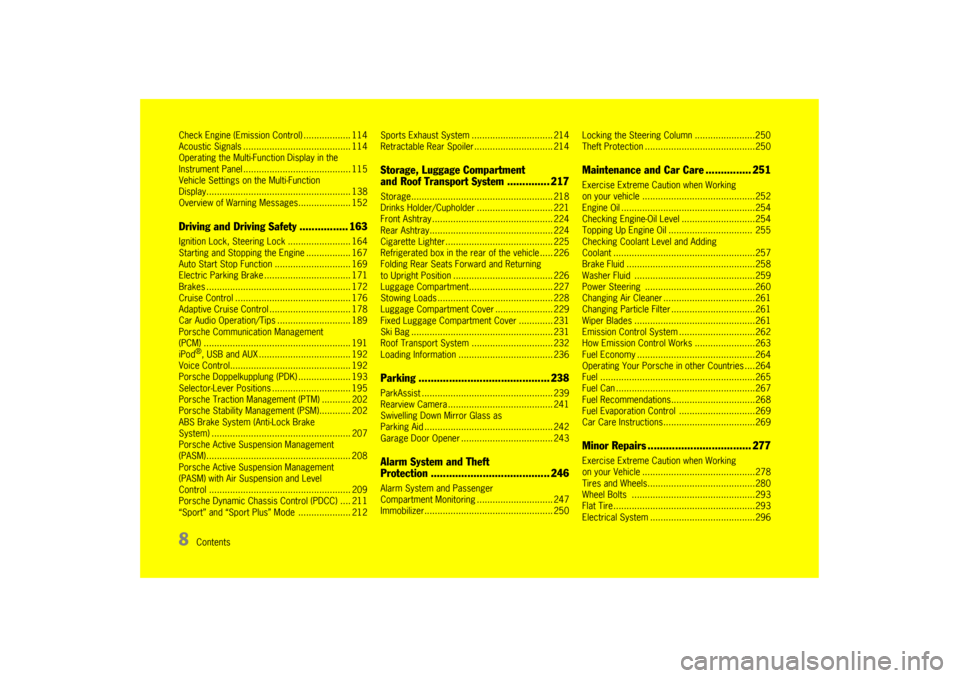
8
Contents
Check Engine (Emission
Control) .................. 114
Acoustic Signals ......... ................................ 114
Operating the Multi-Function Display in the
Instrument Panel ......... ................................ 115
Vehicle Settings on the Multi-Function
Display........................................... ............ 138
Overview of Warning Messages.................... 152
Driving and Driving Safety ................ 163Ignition Lock, Steering Lock ........................ 164
Starting and Stopping the Engine ................. 167
Auto Start Stop Functi on ............................. 169
Electric Parking Brak e ................................. 171
Brakes .............. ......................... ................ 172
Cruise Control ................................ ............ 176
Adaptive Cruise Contr ol ............................... 178
Car Audio Operation/Ti ps ............................ 189
Porsche Communication Management
(PCM) ............................ ............................ 191
iPod
®, USB and AUX ....... ............................ 192
Voice Control.............. ................................ 192
Porsche Doppelkupplung (PDK) .................... 193
Selector-Lever Positions .................. ............ 195
Porsche Traction Management (PTM) ........... 202
Porsche Stability Management (PSM)............ 202
ABS Brake System (Anti-Lock Brake
System) ......................... ............................ 207
Porsche Active Suspension Management
(PASM)....................................................... 208
Porsche Active Suspension Management
(PASM) with Air Suspension and Level
Control ............. ......................... ................ 209
Porsche Dynamic Chassis Control (PDCC) .... 211
“Sport” and “Sport Plus ” Mode .................... 212 Sports Exhaust System
............................... 214
Retractable Rear Spoi ler .............................. 214
Storage, Luggage Compartment
and Roof Transport System .............. 217Storage........................ .............................. 218
Drinks Holder/Cuphold er ............................. 221
Front Ashtray ................ .............................. 224
Rear Ashtray...................................... ......... 224
Cigarette Lighter....... .................................. 225
Refrigerated box in the re ar of the vehicle..... 226
Folding Rear Seats Forward and Returning
to Upright Position ......................... ............. 226
Luggage Compartment. ............................... 227
Stowing Loads .............. .............................. 228
Luggage Compartment Cover ...................... 229
Fixed Luggage Compartm ent Cover ............. 231
Ski Bag ........................ .............................. 231
Roof Transport System ............................... 232
Loading Information .. .................................. 236Parking .................... ....................... 238ParkAssist ......................................... ......... 239
Rearview Camera ...... .................................. 241
Swivelling Down Mirror Glass as
Parking Aid ............... .................................. 242
Garage Door Opener . .................................. 243Alarm System and Theft
Protection ....................................... 246Alarm System and Passenger
Compartment Monitori ng ............................. 247
Immobilizer............... .................................. 250 Locking the Steering Column .......................250
Theft Protection ..........
................................250
Maintenance and Car Care ............... 251Exercise Extreme Caution when Working
on your vehicle ....... ....................................252
Engine Oil ........................................ ...........254
Checking Engine-Oil Le vel ............................254
Topping Up Engine Oi l ................................ 255
Checking Coolant Level and Adding
Coolant ........................... ...........................257
Brake Fluid ................. ................................258
Washer Fluid .............. ................................259
Power Steering .......... ................................260
Changing Air Cleaner ...................................261
Changing Particle Filt er ................................261
Wiper Blades .............. ................................261
Emission Control Syst em .............................262
How Emission Control Works .......................263
Fuel Economy ............. ................................264
Operating Your Porsche in other Countries ....264
Fuel ............................................ ...............265
Fuel Can ..................... ................................267
Fuel Recommendations ................................268
Fuel Evaporation Control .................. ...........269
Car Care Instructions ...................................269Minor Repairs .................................. 277Exercise Extreme Caution when Working
on your Vehicle ....... ....................................278
Tires and Wheels......... ................................280
Wheel Bolts ............... ................................293
Flat Tire...................... ................................293
Electrical System ........ ................................296
Page 32 of 343
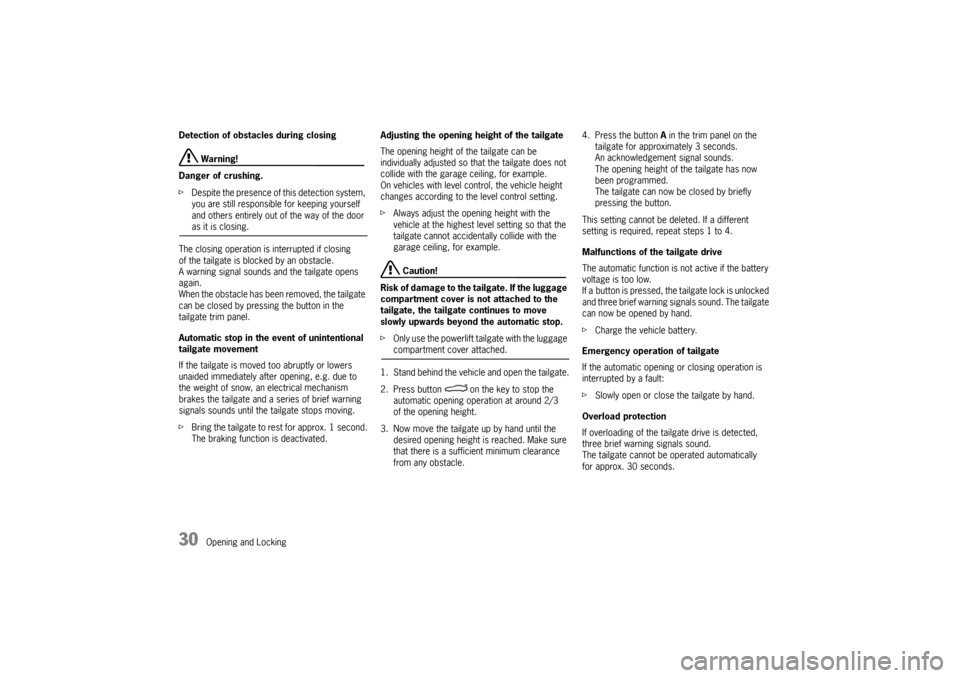
30
Opening and Locking
Detection of obstacles during closing Warning!
Danger of crushing.
f Despite the presence of this detection system,
you are still responsible for keeping yourself
and others entirely out of the way of the door as it is closing.
The closing operation is interrupted if closing
of the tailgate is blocked by an obstacle.
A warning signal sounds and the tailgate opens
again.
When the obstacle has been removed, the tailgate
can be closed by pressing the button in the
tailgate trim panel.
Automatic stop in the event of unintentional
tailgate movement
If the tailgate is moved too abruptly or lowers
unaided immediately after opening, e.g. due to
the weight of snow, an electrical mechanism
brakes the tailgate and a series of brief warning
signals sounds until the tailgate stops moving.
f Bring the tailgate to rest for approx. 1 second.
The braking function is deactivated. Adjusting the opening height of the tailgate
The opening height of the tailgate can be
individually adjusted so
that the tailgate does not
collide with the garage ceiling, for example.
On vehicles with level control, the vehicle height
changes according to the level control setting.
f Always adjust the opening height with the
vehicle at the highest level setting so that the
tailgate cannot accidentally collide with the
garage ceiling, for example.
Caution!
Risk of damage to the tailgate. If the luggage
compartment cover is not attached to the
tailgate, the tailgate continues to move
slowly upwards beyond the automatic stop.
f Only use the powerlift tailgate with the luggage compartment cover attached.
1. Stand behind the vehicl e and open the tailgate.
2. Press button on the key to stop the automatic opening operation at around 2/3
of the opening height.
3. Now move the tailgate up by hand until the desired opening height is reached. Make sure
that there is a sufficient minimum clearance
from any obstacle. 4. Press the button
A in the trim panel on the
tailgate for approximately 3 seconds.
An acknowledgement signal sounds.
The opening height of the tailgate has now
been programmed.
The tailgate can now be closed by briefly
pressing the button.
This setting cannot be deleted. If a different
setting is required, repeat steps 1 to 4.
Malfunctions of the tailgate drive
The automatic function is not active if the battery
voltage is too low.
If a button is pressed, th e tailgate lock is unlocked
and three brief warning sign als sound. The tailgate
can now be opened by hand.
f Charge the vehicle battery.
Emergency operation of tailgate
If the automatic opening or closing operation is
interrupted by a fault:
f Slowly open or close the tailgate by hand.
Overload protection
If overloading of the tailgate drive is detected,
three brief warning signals sound.
The tailgate cannot be operated automatically
for approx. 30 seconds.
Page 165 of 343
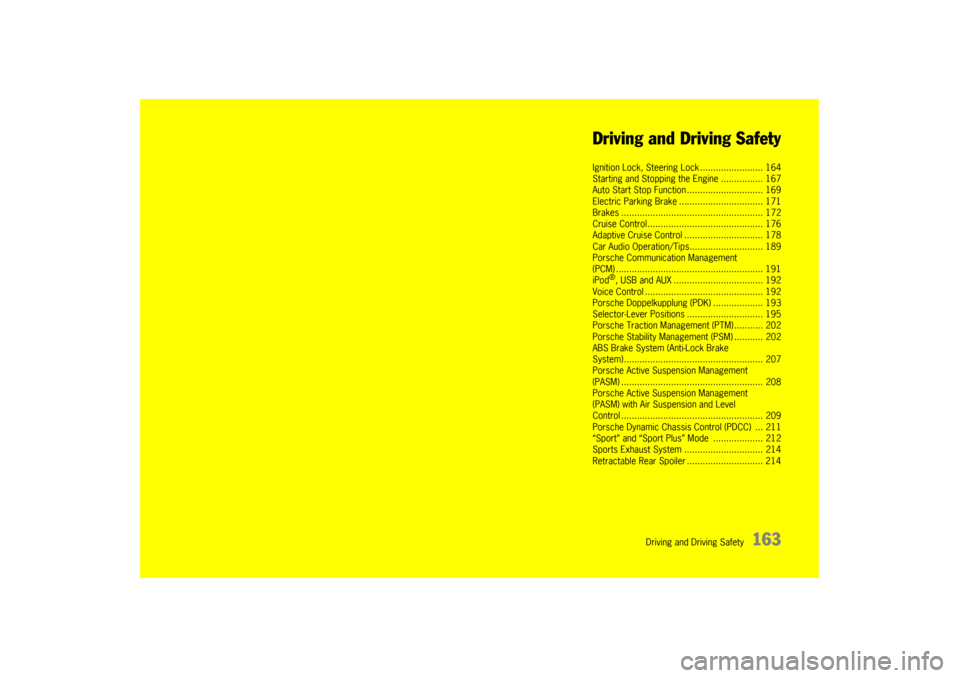
Driving and Driving Safety
163
Driving and Driving Safety
Ignition Lock, Steering
Lock ........................ 164
Starting and Stopping the Engine ................ 167
Auto Start Stop Func tion ............................. 169
Electric Parking Brak e ................................ 171
Brakes ........................ .............................. 172
Cruise Control......... ................................... 176
Adaptive Cruise Contr ol .............................. 178
Car Audio Operation/Ti ps............................ 189
Porsche Communication Management
(PCM) .......................... .............................. 191
iPod
®, USB and AUX ........ .......................... 192
Voice Control ............... .............................. 192
Porsche Doppelkupplung (PDK) ................... 193
Selector-Lever Positi ons ............................. 195
Porsche Traction Management (PTM) ........... 202
Porsche Stability Management (PSM) ........... 202
ABS Brake System (Anti-Lock Brake
System)....................... .............................. 207
Porsche Active Suspension Management
(PASM) ............................................ .......... 208
Porsche Active Suspension Management
(PASM) with Air Suspension and Level
Control ............................................ .......... 209
Porsche Dynamic Chassis Control (PDCC) ... 211
“Sport” and “Sport Plus ” Mode ................... 212
Sports Exhaust Syst em .............................. 214
Retractable Rear Spoiler ............................. 214
Page 174 of 343

172
Driving and Driving Safety
If the electric parking brake could not be applied
fully when the vehicle is stopped, the brake
warning light on the instrument panel starts to
flash.
For information on warning messages on the
multi-function display:
f
Please see the chapter “OVERVIEW OF
WARNING MESSAGES” on page 152.
BrakesfMake it a habit to chec k the operation of your
brakes before driving.
Keep in mind that the braking distance increases
very rapidly as the speed increases. At 60 mph
(100 km/h), for example, it is not twice but four
times longer than 30 mph (50 km/h). Tire traction
is also less effective when the roads are wet or
slippery.
f Therefore, always maintain a safe distance
from the car in front of you.Vehicles without Porsche Ceramic
Composite Brake (PCCB)Even though the brake discs consist of alloyed
grey cast iron, they will unavoidably start to
corrode if your car is parked for an extended
period. The brakes will tend to “rub” as a result.
The nature, extent and effects of corrosion
depend on the amount of time the vehicle was
parked, whether road salt or grit was spread and
whether grease-dissolving agents were used in
car washes.
If the braking comfort is noticeably impaired, we
recommend having the brake system checked by
experts at an authorized Porsche dealer.
Brake system functionYour Porsche is equipped with a power assisted
hydraulic dual circuit brake system with disc
brakes at the front and rear.
Both circuits function independently. One brake
circuit operates the front left and rear right wheel
and the other operates the front right and rear left
wheel.
If one brake circuit has failed, the other will still
operate. However, you will notice an increased
pedal travel when you apply the brakes. Failure of
one brake circuit will cause the stopping distance
to increase.
Warning!
Risk of an accident, resulting in serious
personal injury or death.
In the unlikely event of hydraulic failure of
one brake circuit:
f Push the brake pedal down firmly and hold it in
that position. A mechanical linkage activates
the second circuit, and you will be able to bring
the vehicle to a stop.
f After bringing your vehicle to a complete stop,
avoid driving the vehicle and instead have it
towed to the nearest authorized Porsche dealer for repair.
Brake warning light USA
Brake warning light Canada
Page 175 of 343
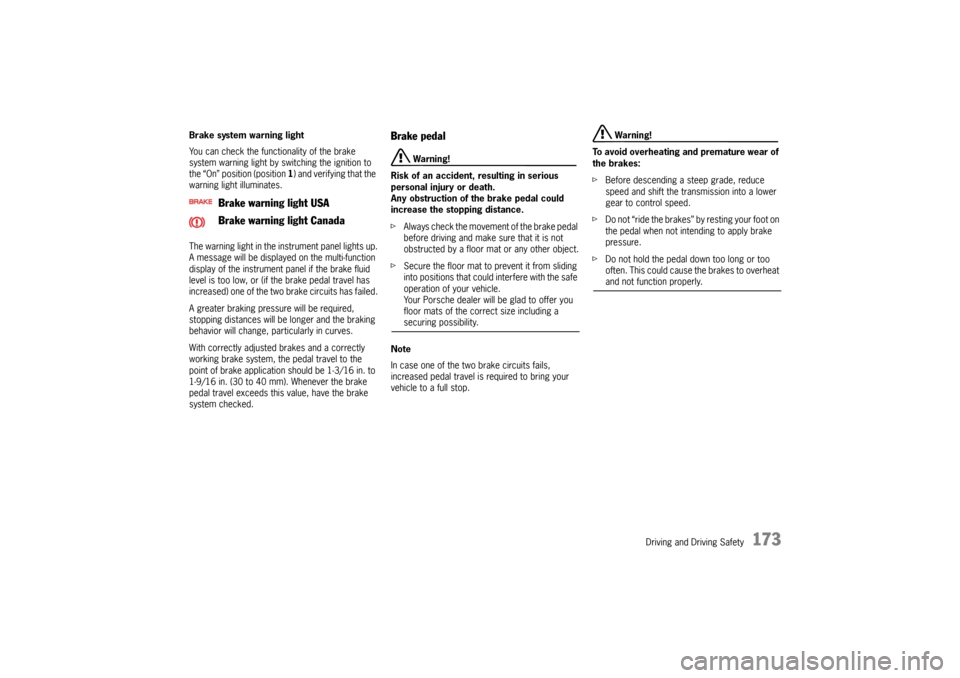
Driving and Driving Safety
173
Brake system warning light
You can check the functionality of the brake
system warning light by switching the ignition to
the “On” position (position 1) and verifying that the
warning light illuminates.
The warning light in the instrument panel lights up.
A message will be displayed on the multi-function
display of the instrument panel if the brake fluid
level is too low, or (if the brake pedal travel has
increased) one of the two brake circuits has failed.
A greater braking pressure will be required,
stopping distances will be longer and the braking
behavior will change, particularly in curves.
With correctly adjusted brakes and a correctly
working brake system, the pedal travel to the
point of brake application should be 1-3/16 in. to
1-9/16 in. (30 to 40 mm). Whenever the brake
pedal travel exceeds this value, have the brake
system checked.
Brake pedal
Warning!
Risk of an accident, resulting in serious
personal injury or death.
Any obstruction of the brake pedal could
increase the stopping distance.
f Always check the movement of the brake pedal
before driving and make sure that it is not
obstructed by a floor mat or any other object.
f Secure the floor mat to prevent it from sliding
into positions that could interfere with the safe
operation of your vehicle.
Your Porsche dealer will be glad to offer you
floor mats of the correct size including a securing possibility.
Note
In case one of the two brake circuits fails,
increased pedal travel is required to bring your
vehicle to a full stop.
Warning!
To avoid overheating and premature wear of
the brakes:
f Before descending a steep grade, reduce
speed and shift the tran smission into a lower
gear to control speed.
f Do not “ride the brakes” by resting your foot on
the pedal when not intending to apply brake
pressure.
f Do not hold the pedal down too long or too
often. This could cause the brakes to overheat and not function properly.
Brake warning light USA
Brake warning light Canada
Page 176 of 343

174
Driving and Driving Safety
Brake boosterThe brake booster assists braking only when
the engine is running.
When the car is moving while the engine is not
running, or if the brake booster is defective, more
pressure on the brake pedal is required to bring
the car to a stop.
Moisture, road salt or grit on brakes affects
braking.
Brakes will dry after a few cautious brake
applications.
Warning!
Risk of an accident, resulting in serious
personal injury or death.
Driving through water may reduce the
traction. Moisture on brakes from road
water, car wash, or a coating of road salt or
grit may affect braking efficiency.
f Cautiously apply brakes to test brakes after exposure to road water, etc.
Brake wearYour car has excellent brakes, but they are still
subject to wear. The rate at which they wear
depends on how the brakes are used.
f Have the brake system inspected at the
intervals recommended in your Maintenance
Booklet.
Brake system warning light
You can check the functionality of the brake
system warning light by switching the ignition to
the “On” position (position 1) and verifying that the
warning light illuminates.
A warning message will be displayed on the multi-
function display of the instrument panel if the
brake pads are worn, excessively.
f Do not continue to operate the vehicle.
Have your authorized Porsche dealer inspect
or replace the brake pads.
For information on warning messages on the
multi-function display:
f Please see the chapter “OVERVIEW OF
WARNING MESSAGES” on page 152.
Brake pads and brake discsWear on the brake pads and brake discs depends
to a great extent on the driving style and the
conditions of use and therefore cannot be
expressed in actual miles on the road.
The high-performance brake system is designed
for optimal braking effect at all speeds and
temperatures.
Certain speeds, braking forces and ambient
conditions (e.g. temperature and humidity) can
therefore cause the brakes to “squeal”.
New brake pads or linings
New brake pads have to be “broken in”, and
therefore only attain optimal friction when the car
has covered several hundred miles or km.
The slightly reduced braking ability must be
compensated for by pressing the brake pedal
harder. This applies whenever the brake pads
and/or brake discs are replaced.
Brake wear warning message
Page 177 of 343

Driving and Driving Safety
175
Warning!
f Do not obstruct the pedal travel with floor mats
or other objects.
The brake booster is ready for operation only
while the engine is running.
If the engine is switched off or there is a defect in
the brake booster, much greater force has to be
applied to the pedal when braking.
f Vehicles with defective brakes must not
be towed and must be transported on a flat
bed.
For information on towing and tow-starting:
f Please see the chapter “TOWING” on
page 316.
In heavy rain, while driving through water or after
leaving a car wash, the braking action may be
delayed and increased pressure may be required.
f For this reason, keep further back from the
vehicle in front and “dry” the brakes by
applying them at interval s. Make sure that the
traffic behind you is not affected. After a long drive over salted or gritted roads,
a coating may form on the brake discs and pads
that significantly reduces
friction and therefore
also braking effect.
f Even though the brake discs consist of alloyed
grey cast iron, they will unavoidably start to
corrode if your vehicle is parked for an
extended period. The brakes will tend to “rub”
as a result.
The nature, extent and effects of corrosion
depend on the amount of time the vehicle was
parked, whether road salt or grit was spread
and whether grease-dissolving agents were
used in car washes (not on vehicles with
Porsche Ceramic Composite Brake).
To prevent corrosion of the brake discs,
“brake them dry” before parking the vehicle
(not on vehicles with Porsche Ceramic
Composite Brake).
If braking comfort is no ticeably impaired, we
recommend that you have the brake system
checked by an authorized Porsche dealer. f
To relieve the brake system on downhill
stretches, change down to a lower gear in
good time (engine braking).
If engine braking is insufficient on steep
stretches, operate the footbrake at intervals.
Avoid continuous braking as it overheats the
brakes and reduces the braking effect.
For information on brake fluid and checking the
brake fluid level:
f Please see the chapter “BRAKE FLUID” on
page 258.
Page 184 of 343

182
Driving and Driving Safety
Switching adaptive cruise control on
and offSwitching adaptive cruise control on
fPress button R on the control stalk.
The grey status display appears on the
multi-function display.
Adaptive cruise control is ready.
Switching adaptive cruise control off
f Press button R on the control stalk.
“ACC off” appears on the multi-function
display.
The desired speed that was stored is deleted.
The desired distance is set to the default value.Operating states when adaptive cruise
control is switched onThere are three possible operating states when
adaptive cruise control is switched on.
Adaptive cruise control active
Adaptive cruise control automatically regulates
the speed and distance fr om the vehicle in front.
The status display A turns orange. Adaptive cruise control is ready
Cruise control and distance control is inactive
after pressing the brakes or interrupting by
pressing the control stalk down (position
3, OFF ).
The desired speed that was stored and the
desired distance that was set are retained.
The status display A turns grey.
Adaptive cruise control is active again after
you release the accelerator.
For information on resuming cruise control and
distance control:
f Please see the chapter “RESUMING CRUISE
CONTROL AND DISTANCE CONTROL –
RESUME” on page 185.
Adaptive cruise control passive
Cruise control and distance control is inactive
after pressing the accelerator.
“ACC passive” appears on the multi-function
display.
The desired speed that was stored and the
desired distance that was set are retained.
The status display A turns grey.
Adaptive cruise control is active again after
you release the accelerator.
Setting and changing the desired speedPreconditions
– ACC is switched on.
– Vehicle is moving.
– No stationary objects are detected in front.
Setting the desired speed
1. Press the control stalk on the steering wheel forward (position 1).
The current driving speed is stored as the
desired speed, which will be maintained
automatically (within the control range from 20
to 100 mph, 30 to 210 km/h), and appears
orange in the status display A.
The red triangle B under the progress bar for
the speed control range shows the speed of
your vehicle.
2. Release the accelerator pedal. The desired speed is maintained automatically
unless a vehicle travelling in front is detected
as driving slower than the desired speed.
Note
If your vehicle is stopped, the message
“Impossible when parked” appears on the multi-
function display when you press the control stalk
forward (position 1).
If a stationary object wa s detected in front, the
message “Stationary ob ject” appears on the
multi-function display.
Page 197 of 343

Driving and Driving Safety
195
Selector-Lever PositionsP – Parking lockfEngage parking lock only when the vehicle is
stationary.
If selector-lever position P is flashing in the
instrument panel, the parking lock is not
engaged. The vehicle can roll away.
Shift again from selector-lever position R to P.
f Activate the electric parking brake and then
engage the parking lock.
If selector-lever position P is flashing in the
instrument panel, the parking lock is not
engaged. The vehicle can roll away.
Shift again from selector-lever position R to P.
The ignition key can be removed only in selector-
lever position P.R – Reverse gearf Select only if the vehicl e is stationary and the
brake is applied.N – Neutral (idling)Selector-lever position N must be selected for
towing or in car washes, for example.
f Only select the desired position for driving off
(D , M or R) when the engine is idling and the
brake pedal is pressed.
D – Automatic selection modeSelect position D for “normal” driving. The gears
are shifted automatically according to the
accelerator position and speed.
Depending on the way the vehicle is driven
(economical, comfortable or sporty driving style)
and on the resistance (e.g. uphill), the gear-
changing points are shifted towards higher or
lower engine-speed ranges.
The accelerator position, driving speed, engine
speed, longitudinal and lateral acceleration and
the road profile all have an influence on the gear-
changing characteristic.
Unwanted upshifts, e.g. when entering
bends, are prevented by swiftly releasing the
accelerator pedal.
Depending on lateral acceleration, upshifts on
bends are not made until the engine-speed limit
is reached.
When you brake, and depending on the amount of
deceleration, the PDK transmission changes down
earlier.
For subsequent cornering, the right gear is
engaged when pressure is applied to the brakes
before the bend. The bend is taken in the right
gear, and when you accelerate out of the bend you
do not have to change down.
With a sporty driving style, downshifts are already
initiated when the brake pedal is touched lightly.
This further enhances a dynamic driving style. The PDK transmission temporarily changes to the
sportiest gear-changing map, i.e. to the highest
possible gear-changing points, if the accelerator
pedal is pressed quickly. The transmission
accordingly shifts down
immediately by one or
two gears (temporary change-down).
The transmission no longer selects 7th gear
at high driving speeds.
“Sport” and “Sport Plus” Mode “Sport” mode activated:
The PDK transmission switches to a sporty gear-
changing map and shortens the shifting times.
A sporty driving style is recognized more quickly
and the gear-changing speeds are adapted to
driving performance.
Deceleration downshifts are initiated earlier.
Downshifts occur for small decelerations,
even at higher revs.
“Sport Plus” mode activated:
In “Sport Plus” mode, the PDK transmission
changes to a shift program designed for driving
on race circuits. 7th gear is not selected.
The gear-changing performance is enhanced
significantly again compared with “Sport” mode.
f Please see the chapter ““SPORT” AND “SPORT
PLUS” MODE” on page 212.